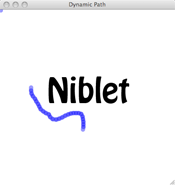Qt for Games – Niblet #1
July 19, 2008A few days ago, I decided to experiment with Qt as it applies to game development. You haven’t heard of Qt? Well, it’s an SDK for cross-platform development which has really started to take off in the cross-platform arena over the last couple of years. KDE, a desktop platform for Linux, is based on the Qt library; so is the VOIP application called Skype. They even have a mobile platform called Qtopia for those who are interested in small devices. You can find out more information on the Trolltech website.
To begin the project and to get the brain juices flowing (after the second cup of coffee, of course), I wanted to come up with a small, interactive demo which would make use of some of the classes related to QSceneGraph and QGraphicsItem. I also wanted to play around with the layers a little bit and see how suitable they would be for games. The first program is a simple one indeed; in fact, it’s not really a game at all – unless of course you’re really bored and you start to chase invisible dots on your screen. Just run demo, and you’ll understand what I’m talking about.
I am basing this project off a classic so that I don’t stray too far off topic. MS-DOS 5.0 shipped with a QBasic game called Nibbles. The game play revolves around a worm that you control through a maze of walls while looking for food. If your worm collides with a wall or itself, you lose one life. The difficulty revolves around the worm’s velocity; it gets faster as you advance. The idea is to use that basic game as a model at first and build on it a little as time goes on; this will help to keep the project focused, which can be a real challenge for those who are new to game programming. To get things started, I have decided to dub the codename for the project: Niblet. The real name will be decided, if and when, this Qt game comes together.
The first problem is the worm, of course. It needs to snake around and grow to certain lengths when food pellets are ingested (or numbers as was the case in the original game).; I also like the idea of it shrinking in response to an item collected during the progression through a level. Anyway, the rules can be fleshed out later. For now, let’s just get a very basic framework up and running. To compile the little demo, just run qmake and then make if you’re on Linux or open up the project in Xcode if you’re using Mac OS X; Windows users can open the project in Microsoft Visual Studio. If you’re using Mac OS X Leopard, I suggest you try out Qt 4.4 which will produce a proper project file for Xcode 3.1.

As you can see, very little code is needed when using Qt. If you were to write the same program for Windows using DirectX or even through the GDI, you would need considerably more code just to handle the application start-up process and surface initialization. But that’s the beauty of these SDKs, they essentially handle a lot of the routine programming so you can concentrate on building your software faster and better using these handy libraries.
Categories: Game Development, Programming
No Comments »







No Responses to “Qt for Games – Niblet #1”
Care to comment?